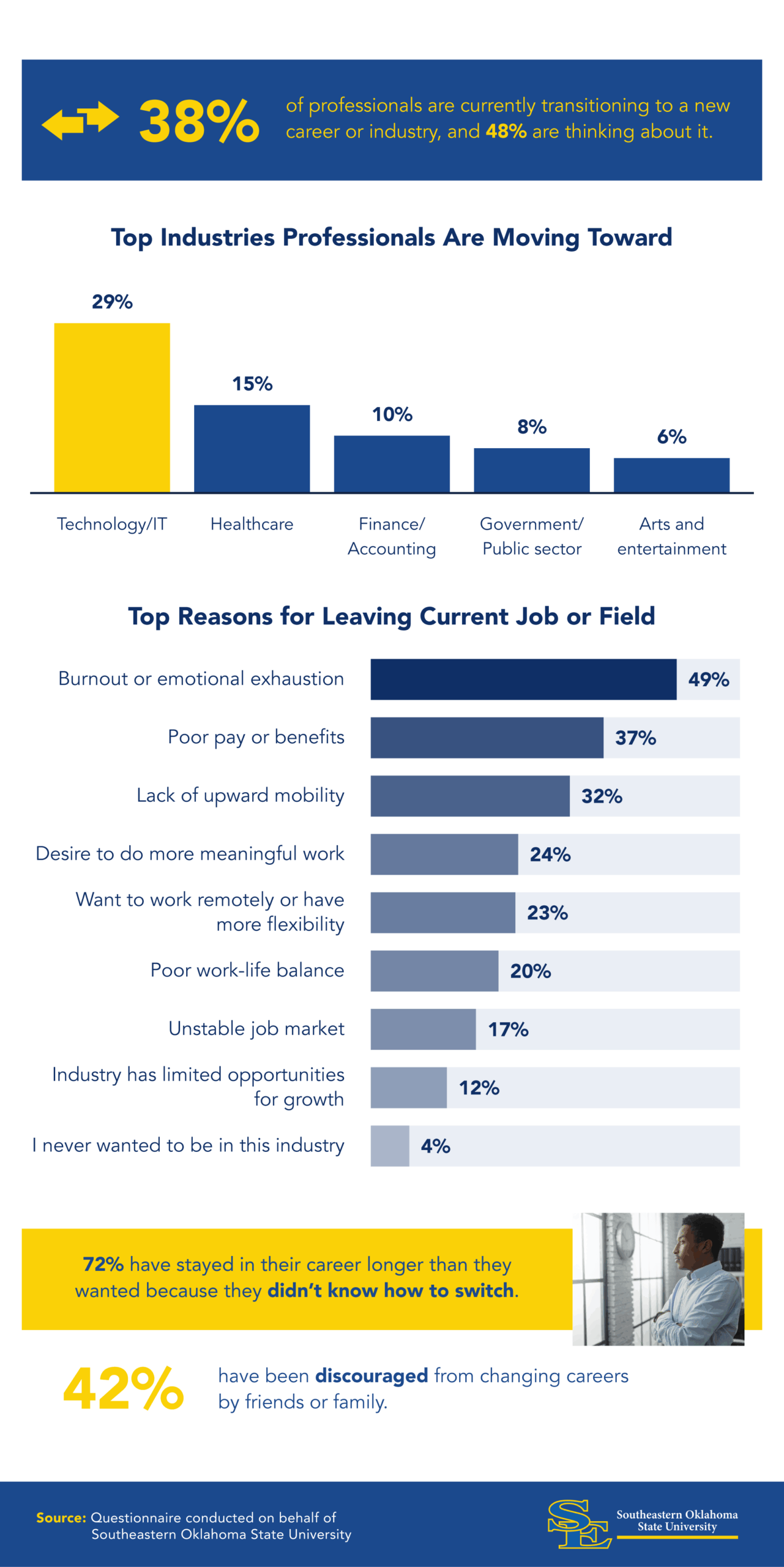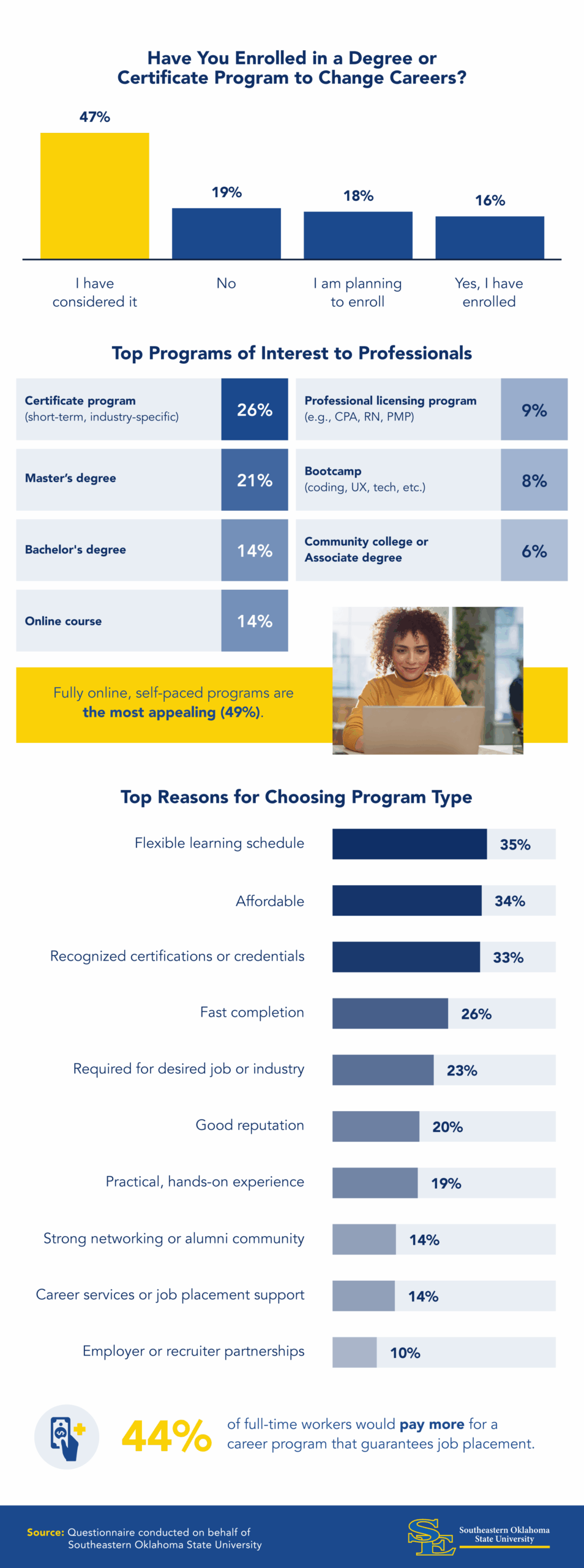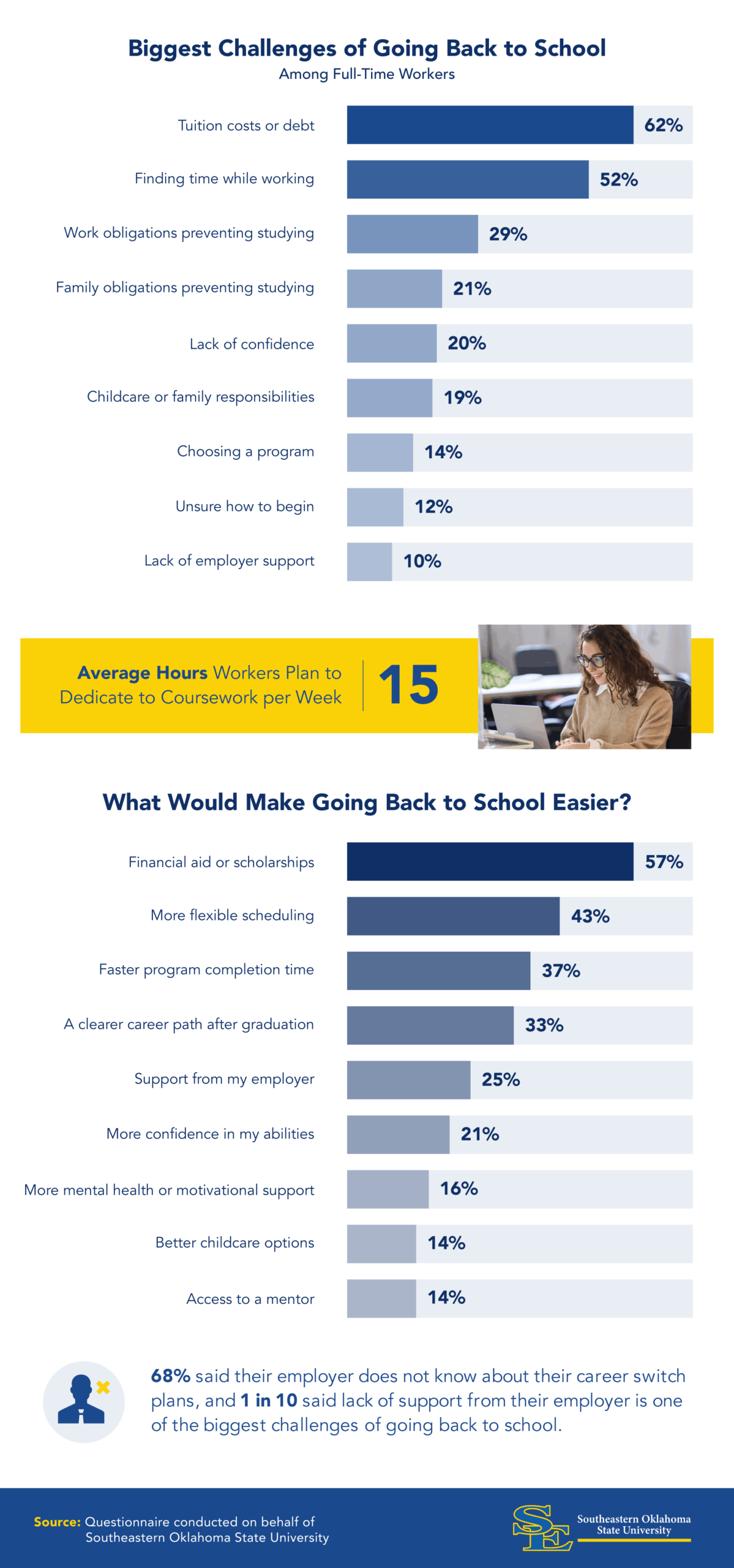
The job market has shifted dramatically in recent years, prompting many professionals to rethink their career paths. For those feeling stuck in a current career or seeking opportunities in a different field, returning to school has become a practical step toward making a change.
To better understand Americans’ career decisions and educational aspirations, a questionnaire of 1,000 full-time workers was conducted on behalf of Southeastern Oklahoma State University. These workers had either enrolled in or considered enrolling in a degree or certificate program within the past two years.
The questionnaire aimed to examine the challenges, motivations and opportunities faced by adults who are preparing to change careers. This report also includes a quick-start guide for professionals thinking of going back to school for a new career.
Key Takeaways
- 38% of professionals are currently changing careers, and 48% are considering it.
- 72% of professionals report staying in their job longer than they wanted because they didn’t know how to switch careers.
- 42% of professionals say they have been discouraged from switching careers by family or friends.
- 68% of professionals say their employer is not aware of their career change
- 10% of professionals say a lack of employer support is one of their biggest challenges in returning to school.
Which Industries Are People Transitioning to?
Career changers are looking for fresh opportunities that offer stability, growth and purpose. Many are leaving their current job to pursue a new challenge in industries that promise professional development and more rewarding work environments.

At the time of the questionnaire, nearly four in 10 professionals (38%) said they were already switching careers or industries, and 48% were considering it. Gen Z professionals stood out, with 44% reporting that they were actively transitioning to a new career.
For many, the decision to change careers is connected to well-being, as burnout and stress drove 49% of professionals to look for healthier work environments. Others pointed to poor pay and benefits (37%), limited upward mobility (32%), or the desire for more meaningful work (24%).
Technology and IT emerged as the leading destinations, with 29% of career changers moving toward these fields. Healthcare was the next most popular choice at 15%, followed by finance and accounting at 10%, the public sector at 8%, and arts and entertainment at 6%. However, switching careers is not without its hurdles.
More than seven in 10 professionals reported staying in a role longer than they wanted because they did not know how to make the transition. Younger workers, including 73% of millennials and 71% of Gen Z, reported the same challenge. To make matters more complex, 42% said they had been discouraged by family or friends from pursuing a new career path, showing how social pressures can slow down career decisions.
What Adult Learners Value Most
When it comes to preparing for a new career, adult learners seek programs that fit their lives and provide practical outcomes. From flexible scheduling to recognized credentials, students weigh a variety of educational and career choices before committing to a learning program.

Many professionals have already taken steps toward their new career goals. Sixteen percent said they had enrolled in a degree or certificate program to change careers, and 18% planned to do so in the future. Nearly half (47%) had at least considered enrollment, reflecting strong interest in upskill opportunities that support professional development and new career options.
Professionals were most interested in pursuing a short-term, industry-specific certification program (26%) and a master’s degree (21%). They also said online self-paced programs are the most appealing educational format. For many job seekers, the quality of career services matters as much as the learning experience. In fact, 44% said they would pay more for a program that guaranteed job placement.
When selecting an educational program, flexibility was the most important factor to workers, followed by affordability, recognized credentials and quick completion. For adults balancing part-time or full-time work, the ability to learn on their own schedule often determines whether continuing education feels realistic and achievable.
What It Takes to Return to School Mid-Career
Balancing the demands of education with a full-time career requires planning and persistence, but many professionals find the effort worthwhile. While challenges can make the transition difficult, resources like financial aid and supportive career services help make returning to school easier.

Tuition and debt were the top concerns among full-time workers, with 62% citing financial strain as their biggest barrier. Time management was also an obstacle, as 52% said it was difficult to balance coursework with their current job. Another 29% noted that work obligations interfered with their ability to study. On average, respondents said they dedicated or planned to dedicate about 15 hours per week to their studies.
Two-thirds of professionals said their employer did not know about their plans to pursue a new career path, and 10% pointed to a lack of support at work as a major challenge. While some try to manage job applications, informational interviews and coursework privately, the absence of understanding from an employer can make work-life balance even harder.
Despite these barriers, there are ways to make the process more manageable. More than half of the respondents (57%) said financial aid or scholarships would help, while others emphasized the importance of flexible scheduling (43%) and faster program completion (37%). These resources could give professionals the foot in the door they need to pursue a new role and create long-term stability after years of experience in a previous career.
Career Change Guide: Returning to School
Starting a new career is a big step, and it is normal to feel unsure about where to begin. Going back to school can help you build the skills and credentials you need, but the process is easier when you have a clear plan. Here are some tips and practical career advice to help you get started.
Step 1: Research Career Paths
Before choosing an educational program, take time to explore which careers fit your skills, values and long-term goals. This approach will help you avoid investing in the wrong path and give you confidence in your next steps.
Best tips:
- Use career guides and labor market data to identify and understand growing industries and in-demand roles.
- Look at job postings to see what employers require in terms of skills, education and experience.
- Conduct informational interviews with professionals in roles that interest you to learn about daily responsibilities, must-have skills and how they got started.
- Shadow or volunteer in a related role, if possible, to get firsthand experience.
- Assess your strengths and values using career assessments or reflection exercises to make sure your path aligns with what matters most to you.
Step 2: Create Your Career Switch Plan
Once you’ve chosen a career path, the next step is to build a clear plan for how to get there. Having a roadmap keeps you focused, helps you set realistic expectations and makes the transition more manageable.
Best tips:
- Identify skill gaps by comparing job postings with your current skills and experience.
- Outline education and training needs, such as degrees, certifications or short-term courses that will qualify you for your new field.
- Set a timeline with milestones like completing prerequisites, applying to programs and finishing coursework.
- Budget for costs by researching tuition, financial aid and scholarship opportunities.
- Find guidance and accountability through a career coach, mentor or trusted advisor who can review your plan and keep you on track.
Step 3: Take Action
With your career path chosen and a plan in place, it’s time to move forward. Start small to keep the process from feeling overwhelming.
Best tips:
- Apply to programs that fit your goals, budget and preferred learning format.
- Begin networking early by connecting with alumni, professional groups and mentors.
- Develop new skills right away through online courses, workshops or certifications.
- Stay flexible and adjust your plan as you discover new opportunities or challenges.
- Celebrate progress at each milestone to stay motivated.
After completing your program, focus on preparing for the job market. Update your resume to highlight new skills and certifications and showcase how your education connects to the roles you want. Strengthen your LinkedIn profile, continue networking and practice interviewing so you can confidently present your new qualifications. These steps will help you turn your education into real opportunities in your chosen field.
Finding the Confidence to Start a New Chapter
Changing careers is not an easy decision, but many professionals are ready to take steps toward new opportunities. Returning to school provides adult learners with the tools, skills and confidence to transition into a new job or industry that better aligns with their goals. While challenges such as cost, time and limited support remain, flexible educational programs and financial resources can make the path more accessible.
Southeastern supports professionals through online degree options designed to help students balance work and education. With affordable tuition, flexible formats and dedicated faculty, Southeastern makes it possible for working adults to pursue new opportunities without putting their current responsibilities on hold. With the right preparation and support, professionals can successfully navigate a career change and create lasting growth in their personal and professional lives.
Methodology
This questionnaire of 1,000 full-time workers was conducted on behalf of Southeastern Oklahoma State University on September 4, 2025, to explore career change sentiments. Respondents were eligible if they were transitioning careers or industries. This sample is not intended to reflect the experiences of all working adults. Results provide a snapshot in time based on when the data was collected, and they may shift as economic or industry conditions change.
About Southeastern Oklahoma State University
Southeastern Oklahoma State University offers flexible degree programs designed for working adults who want to advance or change their careers. Southeastern’s online Master of Business Administration (MBA) programs help students gain leadership skills that translate across industries. With affordable tuition, supportive faculty and a commitment to student success, Southeastern empowers adult learners to build a stronger future through education.
Fair Use Statement
The information in this article may be used for noncommercial purposes only. If you share it, please provide proper attribution with a link to Southeastern Oklahoma State University.